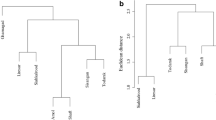Abstract
The identification of populations of Bruguiera sexangula, Bruguiera gymnorhiza and their putative hybrids in the field is difficult using only morphological and phenological characters. Using a PCR based technique, RAPD (Random Amplified Polymorphic DNA), the genetic variation of Bruguiera populations was studied from contrasting climatic and geographic regions along the southwest coastal region of Sri Lanka. Out of 45 primers screened, 20 primers allowed us to observe polymorphism, not only between species (interspecific) but also within the species (intraspecific). Analysis of RAPD data appears to be helpful in determining the genetic relationship among populations of B. gymnorhiza and B. sexangula. RAPD markers revealed that the two species are well separated without any hybrid position between the two taxa though they occur in mixed stands. Although sampling sizes of populations of this study were small, genetic variation among B. gymnorhiza and B. sexangula populations could be observed. For B. sexangula, it was possible to differentiate each of the three populations, even when using a small number of primers.
Similar content being viewed by others
References
Aldrich, P. R., J. Doebley, K. F. Schertz & A. Stec, 1992. Patterns of allozyme variation in cultivated and wild Sorghum bicolor. Theor. Appl. Genet. 8: 451–460.
Amarasinghe, M. D. & S. Balasubramaniam, 1992. Structural properties of mangrove stands on the northwestern coast of Sri Lanka. Hydrobiologia 247: 17–27.
Arulchelvam, K., 1968. Mangroves. The Ceylon Forester 314: 59–92.
Corredor, J. E., J. M. Morell, E. J. Klekowski Jr. & R. Lowenfeld, 1995. Mangrove genetics. III. Pigment fingerprinting of chlorophyll-deficient mutants. Int. J. Plant. Sci. 156: 55–60.
Dahdouh-Guebas, F., A. Verheyden, W. De Genst, S. Hettiarachi & N. Koedam, Four decade vegetation dynamics in Sri Lankan mangroves as detected from sequential aerial photography: a case study in Galle (Submitted).
Dawson, I. K., A. J. Simons, R. Waugh & W. Powell, 1995. Diversity and genetic differentiation among subpopulations of Gliricidia sepium revealed by PCR-based assays. Heredity 74: 10–18.
Dawson, I. K., A. J. Simons, R. Waugh & W. Powell, 1996. Detection and pattern of interspecific hybridisation between Gliricidia sepium and G. maculata in Meso-America revealed by PCR-based assays. Molec. Ecol. 5: 89–98.
De Silva, K. H. G. M. & S. Balasubramaniam, 1985. Some ecological aspects of the mangroves on the west coast of Sri Lanka. Ceylon J. Sci. 18: 22–37.
Dodd, R. S., F. Fromard, Z. A. Rafii & F. Blasco, 1995. Biodiversity among west African Rhizophora: FoliarWax chemistry. Biochem. System. Ecol. 23: 859–868.
Duke, N. C., 1984. A mangrove hybrid, Sonneratia X gulngai (Sonneratiaceae) from north-eastern Australia. Austrobaileya 2: 103–105.
Duke, N. C., 1995. Genetic diversity, distributional barriers and rafting continents - more thoughts on the evolution of mangroves. Hydrobiologia 295: 167–181.
Farnsworth, E. J. & A. M. Ellison, 1997. The global conservation status of mangroves. Ambio 26: 328–334.
Goodall, J. A. & J. A. Stoddart, 1989. Techniques for the electrophoresis of mangrove tissue. Aquat. Bot. 35: 197–207.
Hellier, C., 1988. The mangrove wastelands. The Ecologist 18: 77–79.
Jayawardene, R. P., 1985. The mangroves of Sri Lanka. Bakawan 4: 8–10.
Khasa, P. D. & B. P. Dancik, 1996. Rapid identification of white-Engelmann spruce species by RAPD markers. Theor. Appl. Genet. 92: 46–52.
Klekowski, E. J. Jr., R. Lowenfeld & E. H. Klekowski, 1996. Mangrove genetics. IV. Postzygotic mutations as periclinal chimeras. Int. J. Plant. Sci. 157: 398–405.
Lindén, O. & A. Jernelöv, 1980. The mangrove swamp - an ecosystem in danger. Ambio 9: 81–88.
McKee, K. L., 1995. Interspecific variation in growth, biomass, partitioning and defensive characteristic of neotropical mangrove seedlings: response to light and nutrient availability. Am. J. Bot. 82: 299–307.
McMillan, C., 1986. Isozyme patterns among populations of black mangrove Avicennia germinans, from the gulf of Mexico - Caribbean and Pacific Panama. Contribution in Mar. Sci. 29: 17–25.
Müller-Dombois, D., 1968. Ecogeographical analysis of a climatic map of Ceylon with particular reference to vegetation. The Ceylon Forester 3: 144–164.
Parani, M., M. Lakshmi, S. Elango, N. Ram, C. S. Anuratha & A. Parida, 1997a. Molecular phylogeny of mangroves II. Intraand inter-specific variation in Avicennia revealed by RAPD and RFLP markers. Genome 40: 487–495.
Parani, M., C. S. Rao, N. Mathan, C. S. Anuratha, K. K. & A. Parida, 1997b. Molecular phylogeny of mangroves III. Parentage analysis of a Rhizophora hybrid using random amplified polymorphic DNA and restriction fragment length polymorphism markers. Aquat. Bot. 58: 165–172.
Pemadasa, M., 1996. The green mantle of Sri Lanka. Tharnjee Printers, Maharagama: 1–108.
Rohlf, F. J., 1993. NTSYS-pc. Numerical taxonomy and multivariate analysis system. Applied Biostatistics Inc. New York.
Russell, J. R., F. Hosein, E. Johnson, R. Waugh & W. Powell, 1993. Genetic differentiation of cocoa (Theobroma cacao L.) populations revealed by RAPD analysis. Molec. Ecol. 2: 89–97.
Schierenbeck, K. A., M. Skupski, D. Lieberman & M. Lieberman, 1997. Population structure and genetic diversity in four tropical tree species in Costa Rica. Molec. Ecol. 6: 137–144.
Tingey, S. V. & J. P. Del Tufo, 1993. genetic analysis with random amplified polymorphic DNA markers. Plant Physiol. 101: 349–352.
Tomlinson, P. B., 1986. The botany of mangroves. Cambridge University press, Cambridge.
Triest, L., 1991. Conservation of genetic diversity in water plants. Op. Bot. Belg. 4: 241–258.
Welsh, J. & M. McClelland, 1990. Fingerprinting genomes using PCR with arbitrary primers. Nucleic Acids Res. 18: 7213–7218.
Welsh, J., R. J. Honeycutt, M. McClelland & B. W. S. Sobral, 1991. Parentage determination in maize hybrids using the arbitrarily primed polymerase chain reaction (AP-PCR). Theor. Appl. Genet. 82: 473–476.
Williams, J. G. K. A. R., K. J. Kubelik, J. A. Livak, S. Tingey & V. Rafalski, 1990. DNA polymorphism amplified by arbitrary primers are useful as genetic markers. Nucleic Acids Res. 18: 6531–6535.
Author information
Authors and Affiliations
Rights and permissions
About this article
Cite this article
Abeysinghe, P.D., Triest, L., De Greef, B. et al. Genetic differentiation between Bruguiera gymnorhiza and B. sexangula in Sri Lanka . Hydrobiologia 413, 11–16 (1999). https://doi.org/10.1023/A:1003899028558
Issue Date:
DOI: https://doi.org/10.1023/A:1003899028558




